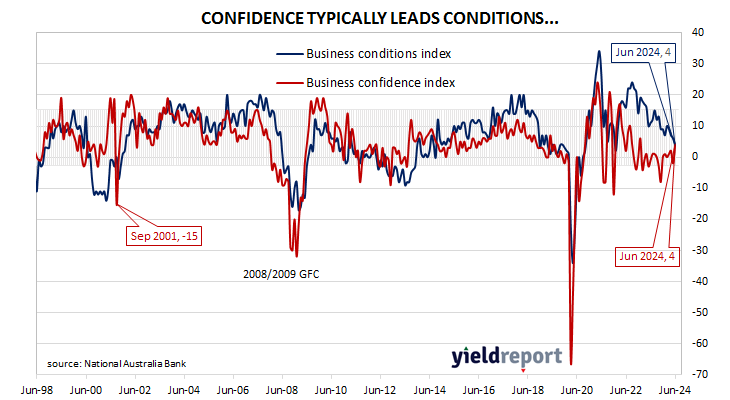Summary: Business conditions deteriorate for fourth consecutive month in June; business confidence improves, still below average; NAB: condition weaken across range of sectors; ACGB yields decline; rate-rise expectations soften; NAB: lines up with slowing in activity but demand still high relative to supply; capacity utilisation rate up, at elevated level.
NAB’s business survey indicated Australian business conditions were robust in the first half of 2018, with a cyclical-peak reached in April of that year. Readings from NAB’s index then began to slip and forecasts of a slowdown in the domestic economy began to emerge in the first half of 2019 as the index trended lower. It hit a nadir in April 2020 as pandemic restrictions were introduced but then improved markedly over the next twelve months and subsequently remained at robust levels until recently.
According to NAB’s latest monthly business survey of around 400 firms conducted in the last week of June, business conditions deteriorated for a fourth consecutive month and are now at a level below the long-term average. NAB’s conditions index registered 4 points, down 2 point from May’s reading.
Conversely, business confidence improved. NAB’s confidence index rose 6 points to +4 points, a reading which is still below the long-term average. NAB’s confidence index typically leads the conditions index by one month, although some divergences have appeared from time to time.
“Conditions declined in wholesale, construction, manufacturing and finance, business and property in the month, with the non-mining goods sectors now clearly softer than the services sectors,” said NAB Chief Economist Alan Oster. “Retail, despite increasing in the month, remains weakest and the only industry in negative territory in trend terms.”
Australian Commonwealth Government bond yields declined modestly across the curve on the day. By the close of business, the 3-year ACGB yield had slipped 1bp to 4.08% while 10-year and 20-year yields both finished 2bps lower at 4.35% and 4.68% respectively.
Expectations regarding rate rises in the next twelve months softened a touch. Cash futures prices at the end of the day implied the cash rate has some chance of rising above the current rate of 4.34% in the short-term, with an average of 4.39% in August, 4.45% in November and 4.425% in February 2025. However, May 2025 contracts implied 4.32%, 2bps less than the current cash rate.
“This all lines up with the slowing in activity we have seen more broadly but also with a still high level of demand, relative to supply in the economy,” Oster added. “Consistent with this, price and cost growth variables generally remain elevated.”
NAB’s measure of national capacity utilisation ticked up from 83.3% to 83.5%, a level which is quite elevated from a historical perspective. Seven of the eight sectors of the economy were reported to be operating at or above their respective long-run averages, the wholesale sector the one exception.
Capacity utilisation is generally accepted as an indicator of future investment expenditure and it also has a strong inverse relationship with Australia’s unemployment rate.



